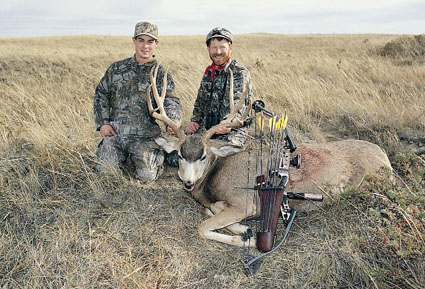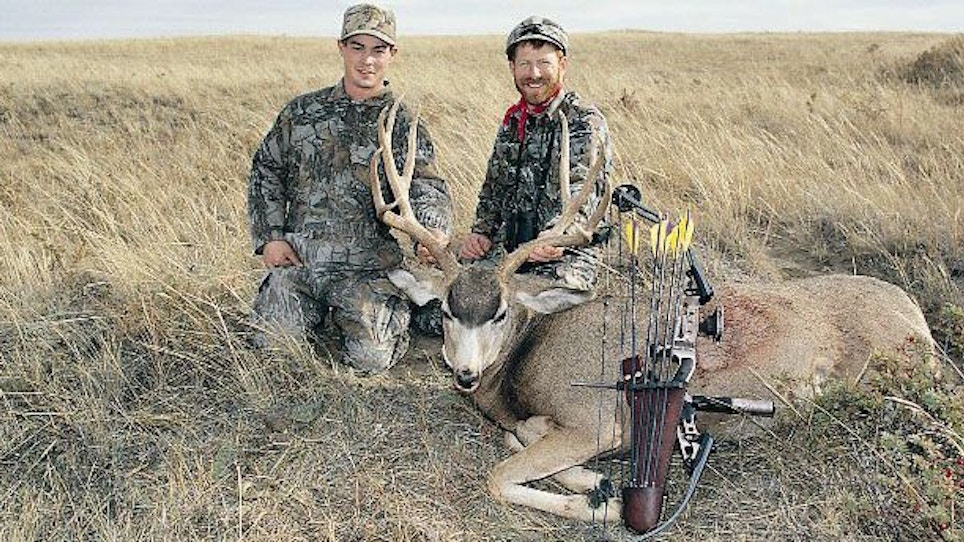 Guide Shaun Steidel (left) and Brandon Ray pose with Ray’s 1999 mule deer taken in Alberta, Canada. |
Less than 100 yards away lay the hidden bodies of four mule deer bucks. The yellow, waving grasses of the large CRP field hid the bucks’ bodies, but the short grass could do nothing to conceal their high, wide antlers. I had first spotted the bucks’ antlers from the elevated vantage of my truck cab, but now I was on the ground with bow in hand and closing the gap.
One of the bucks was a dink 7-point, not even a last-day shooter, but the three remaining bucks were all big enough to make me shake. One was a wide 3x3 with at least 15-inch back tines and heavy bases. His rack was still in perfect velvet. The next buck was a heavy, typical 4x4 with eyeguards, average forks and a couple of extras—one a 4-inch kicker that shot sideways off his left beam and the other a 5-inch kicker within his right front fork. His rack had recently been stripped of its velvet, leaving tattered strips dangling from his bases. His antlers were bloody red.
The last buck was the one I wanted: a symmetrical 4x4 with good brow tines and deep front and back forks. A few small strips of velvet were ripped and hanging off the rack giving the illusion of small non-typical points, but because I’d been watching all of these bucks for a couple of weeks, I knew the exact dimensions of each bucks’ rack by memory. I would shoot the 4x4 with the deep forks if given the chance.
As I stalked on hands and knees through the coarse grass and concrete-hard ground, I kept tabs on the bedded foursome through my 10x binocs. When I’d reached long-distance bow range, I eased up higher than I should have so my rangefinder could nail down the distance to the closest set of antlers.
The old 3x3 caught the movement. As he started to stand, all of the bucks eased to their feet. This was the end of the stalk and my cue to draw. I jerked my bow to full draw and all the bucks just stared. When the big 4x4 was broadside I cut the shot.
The skinny carbon arrow bit deep into the buck’s side. A mere 40 yards later the buck stumbled and collapsed. In a landscape that many would label “unhuntable” for bowhunting, I had scored on a big buck. The unconventional terrain where these bucks lived was at least partially responsible for them reaching maturity and, thus, sporting impressive racks.
Muleys are different from whitetails. The open terrain that muleys prefer is the most noticeable difference between the two species, but there’s also a difference in hunting tactics used for big-eared bucks. Whitetail tactics, like hunting from treestands, do account for some bowkills on muleys each year, but spot-and-stalk hunting is the traditional technique that works out West. By adapting your hunting strategy to the landscape where muleys live, you can consistently put yourself within bow range of Western deer. Whether you hunt in high country mountain terrain, cactus-infested deserts, short-grass prairies, or even in checker-boarded farmland, there are many different looks to today’s mule deer—both in their habitat and the hunting strategies that can help bowhunters score. Knowing when to use each strategy is the key.
Next: Tactics For Farmland, Mountain Spot-and-Stalk, CRP Fields






